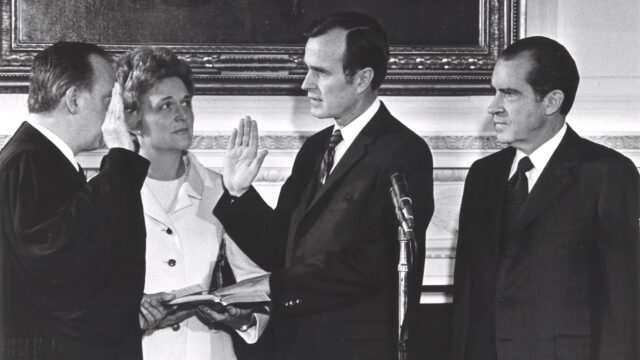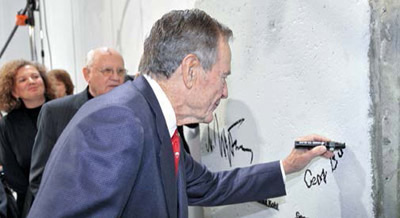
In Memoriam: George Herbert Walker Bush (1924-2018): Veteran, Statesman, Diplomat
On November 30, 2018, former President George Herbert Walker Bush died at age 94.
A distinguished Navy pilot in World War II, former President Bush lived an accomplished life, serving his nation in various capacities, including: President, Vice President, Director of the Central Investigative Agency, Member of both the House and Senate, and as a diplomat, serving as U.S. Ambassador to the United Nations and Head of U.S. Liaison Office in China.
In addition to serving his nation, Bush was a businessman and humanitarian. In George W. Bush’s “41: A Portrait of My Father,” the former president remembers his father’s incredible sense of connecting with people. Uncommon during the time, H.W. Bush made personal courtesy calls on fellow ambassadors in New York—practicing person-to-person diplomacy and building relationships that proved essential during his presidency. “He was down to earth and direct,” his son remembers, “and people liked him for it.”

Inaugurated as President of the United States in January 1989, Bush entered office at a period of change in the world; the fall of the Berlin Wall came early in his presidency, and the collapse of the Soviet Union came in 1991.
Looking back, former Secretary of State James Baker commented, “one of President Bush’s outstanding traits has been his humility, and particularly his insistence after the Iron Curtain fell that Americans not gloat about our victory in the decades-long Cold War against the Soviet empire. In 1989, after all, the president still had further business to do with Soviet leaders even as their country was rapidly imploding. Included on his checklist were nuclear arms reductions, which were later accomplished and have played a critical role in maintaining world peace.” Baker, who was in office when the wall came down in 1989, added: “Time and again, President Bush demanded that we not dance on the ruins of the Berlin Wall. He simply wouldn’t hear of it.”
His previous diplomatic experience as the Ambassador to the United Nations came in handy when, as president, he received word that Iraqi forces had crossed into Kuwait. In the first five days after the invasion, Bush personally telephoned international leaders on at least forty-eight occasions—from the White House, while in-flight aboard Air Force One (where he called King Hussein of Jordan and President Mubarak of Egypt on the first day of the crisis), and from Camp David. Bush also immediately called Thomas Pickering, U.S. Ambassador to the United Nations. He instructed Pickering that he wanted the United Nations to respond swiftly to the invasion. From the outset, Bush viewed the crisis not as a regional Arab-to-Arab dispute, but as something larger. Bush “was keenly aware that this would be the first post–Cold War test of the Security Council in crisis.”
While most U.S. presidents had warily turned to the United Nations in an international crisis, Bush’s immediate call to the United Nations paid dividends. On the day of the invasion, the U.N. Security Council passed resolution 660 by a 14–0 vote, demanding that Iraq withdraw from Kuwait. Significantly, the Soviet Union and China did not veto the resolution despite the fact that Iraq had been an ally and a recipient of Soviet military aid in the past. Bush’s decision to involve the United Nations served as a foundation for his strategy of “coercive diplomacy” — using limited force as a negotiating tactic — over the next five months. Having served as U.N. ambassador meant that he understood both the institution’s limits and strengths and had confidence in its diplomatic mechanisms.
On a lighter note, Bush was known as the “Original Sock Diplomat.” Bush has an assortment of colorful, graphic pairs suited to every occasion. He wore red, white and blue striped numbers to the White House for the unveiling of his son’s official portrait in 2012; Bill Clinton socks to a meeting with Mr. Clinton; and socks from a company started by a man with Down Syndrome on World Down Syndrome Day. Often, the 41st president tweeted about his socks. His affinity for them became even more obvious after he began to use a wheelchair, as his ankles were exposed. He was laid to rest in gray socks patterned with fighter planes flying in formation, and it’s not just because of his service as a naval aviator. It was because, as he wrote of himself in a 2014 fundraising email for the Republican National Committee, “I’m a self-proclaimed sock man. The louder, the brighter, the crazier the pattern — the better.” The week of his passing, a veritable outpouring of creative hosiery appeared on social media and on the streets and in schools, all in honor of Mr. Bush, himself a famous practitioner of the art of sock diplomacy. Business owners encouraged employees to wear socks with lighthearted designs, students were urged to get creative, and a hashtag was created, #SocksforBush.
In this piece, the National Museum of American Diplomacy honors former President Bush’s service to the nation and the world.